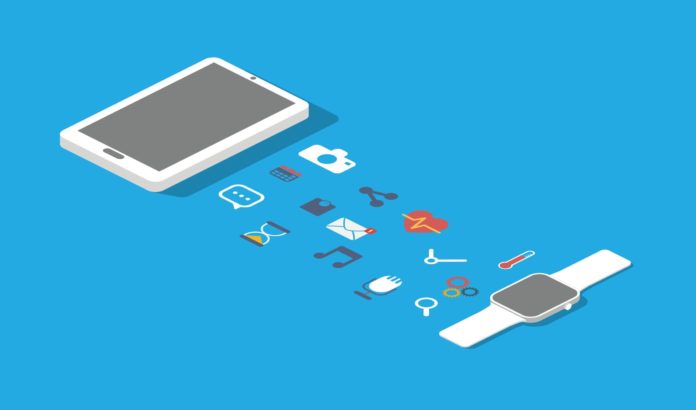Wearable technology has emerged as one of the more ubiquitous applications of the Internet of Things. Worldwide demand for wearables is set to grow exponentially over the next few years; according to the industry analyst CCS Insight, the global wearables market is projected to double by 2022, to $27 billion.
If you’re innovating in the wearables space, one way to retain a competitive edge in a rapidly burgeoning industry is by seeking robust IP protections. But first, you’ll need to understand the state of the art — and the industry is shifting to favor sophisticated devices with expanded capabilities.
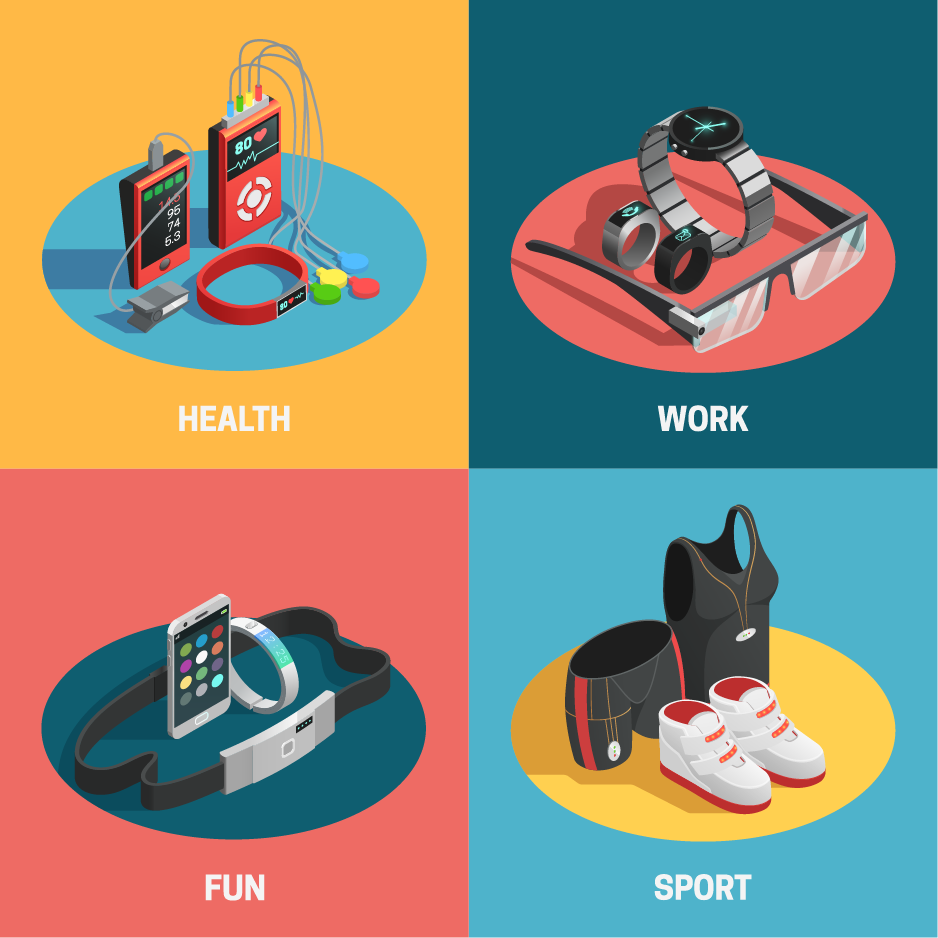
WHAT IS WEARABLES TECHNOLOGY?
“Wearables” refers to smart devices that can be worn on the body, either as an accessory or as part of one’s clothing. Wearables enable the user to automatically access and track information over the internet over the course of their daily activities.
Some well-known examples of wearables:
- Smart watches (e.g., Apple Watch)
- Glasses (e.g., Google Glass)
- Fitness bands (e.g., FitBit)
- Connected apparel (e.g., Sensoria)
- Medical devices (e.g., Aira)
I’d also like to note some common industry terminology that I’ll be using throughout this post:
- Basic wearables refers to devices that provides mostly descriptive feedback (e.g., the number of steps you took per day). Many early devices fit this bill.
- Smart wearables refers to more sophisticated devices that can offer prescriptive and diagnostic services.
WEARABLES MARKET TRENDS: WHAT DO CONSUMERS WANT?
Generally, the global market for wearables is increasing. According to data from the International Data Corporation (IDC) Worldwide Quarterly Wearable Device Tracker, worldwide growth in 2018 was up 5.5% from the previous year.
As a further indicator of the market’s trends, it was announced just earlier this month (on January 17th) that Google would be purchasing the Fossil Group’s intellectual property relating to wearables for $40 million.
TRANSITIONING TOWARD SMART WEARABLES
We can attribute this growth to two major trends. First, emerging markets (Asia/Pacific excluding Japan, Central and Eastern Europe, Middle East and Africa, and Latin America) are showing increased interest in low-priced basic wearables.
Meanwhile, mature markets (North America, Japan, and Western Europe) are transitioning toward smart wearables.
The data backs this up. As the same study shows, in the same time period from 2017 to 2018:
- Mature markets declined 6.3%
- Emerging markets grew 14%
Why is a decline in mature markets considered in line with these expectations? In a nutshell, mature markets were previously saturated with basic wearables; the market is now adjusting to meet the increased demand for smart wearables.
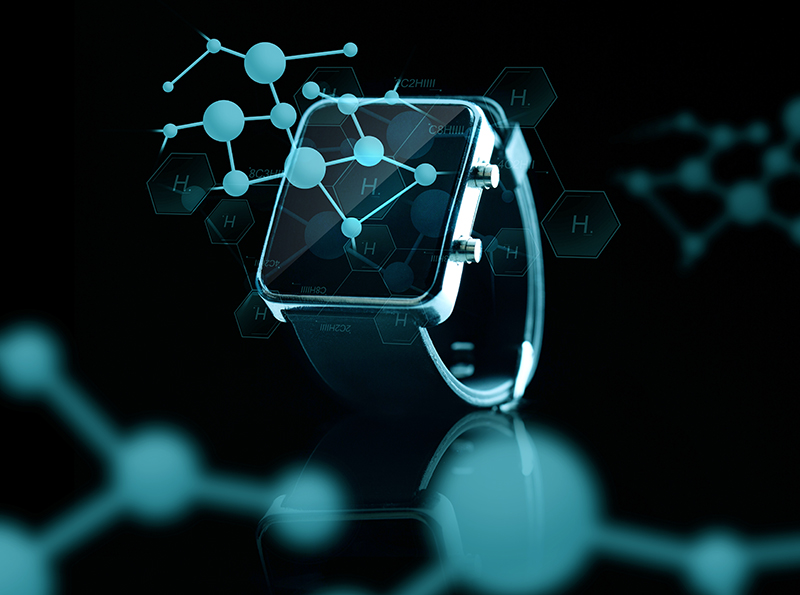
WHAT KINDS OF SMART WEARABLES ARE IN DEMAND?
There are two ways to approach this discussion: by technological application and device type.
First, let’s look at technological application. An analysis by Quid shows that different applications will open up different opportunities:
- Consumers tend to favor health, fitness, and medical use applications of wearables.
- Investors are looking out for smart glasses and augmented reality devices — these markets aren’t as oversaturated.
Next, let’s examine the device types with the strongest market opportunities. According to the IDC’s Worldwide Quarterly Wearable Device Tracker, the global market for the next five years will favor:
- Smartwatches: It’s predicted that smartwatches will account for half of the global wearables market by 2022.
- Earwear (“Hearables”): Between 2018-2022, the projected compound annual growth rate for earwear is 56.3% — the highest of all wearable devices.
Later in this post, we’ll examine what type of devices industry leaders are patenting within each technological application.
MARKET LEADERS IN WEARABLES TECHNOLOGY
According to the IDC, these are the top five companies worldwide by market share in 2018:
| Rank | Brand | 2018 market share | Percentage change from 2017 | Key products and differentiators |
| 1 | Apple | 17.0% | +38.4% | Apple Watch; watchOS |
| 2 | Xiaomi | 15.1% | +19.8% | Diversified its portfolio to include shoes, kids’ watches, and multiple variants of the Mi Band — all priced at the low end of the spectrum |
| 3 | FitBit | 9.5% | -21.7% | Lost steam due to its past reliance on basic fitness trackers, but is regaining footing following its release of the smartwatch Versa |
| 4 | Huawei | 6.5% | +118.1% | The brand is only just beginning to look outside its home country of China. Key products: Huawei Watch; Huawei Band; Huawei TalkBand; Huawei Fit |
| 5 | Garmin | 5.3% | +4.1% | Pivoting to smartwatches over basic wearables; core products include the vivofit and Approach series |
PATENT TRENDS FOR WEARABLES TECHNOLOGY
An analysis performed by Quid on available patent information shows that wearables claims typically involve device communication, as well as displays and lenses.
With that in mind, let’s take a closer look at how the number of wearables-related patent filings has changed over the past two decades. We’ll also examine what types of devices industry leaders are patenting within the most popular technological applications.
NUMBER OF U.S. PATENTS ISSUED FROM 2000-2018
In line with the recent increase in market demand for wearables, the number of patents for wearables has increased significantly starting around 2015:
Increase in wearables patent activity over time
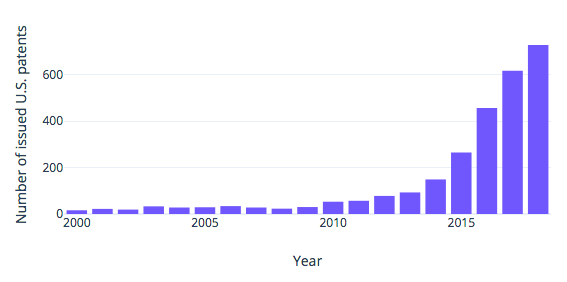
As a caveat, this wasn’t an exhaustive search; we just did a quick sampling of issued U.S. patents based on simple keyword searching through the USPTO search interface. We did not review the individual patents or filter for false hits.
Nevertheless, it’s sufficient to show the year-over-year trend — and in particular, to illustrate how wearables patent activity is sharply increasing alongside the rising ubiquity of sophisticated IoT technologies.
PATENT TRENDS: FITNESS WEARABLES
Fitness wearables refers to any autonomous, noninvasive device that tracks information related to health and fitness. Basic fitness wearables usually serve as physiological monitors, tracking information like walking steps, calories burned during workouts, heart rate, or sleep patterns; smart fitness wearables may include capabilities like predictive information, as well as integration with external applications.
Who are the top industry players, and what are they patenting? According to IPWatchDog:
- Top five U.S. patent assignees for fitness wearables
- Samsung
- Alphabet (Google)
- Microsoft
- Apple
- Qualcomm
- Most commonly patented device types
- Wristwear
- Earwear
PATENT TRENDS: MEDICAL DEVICE WEARABLES
Medical device wearables are defined as any autonomous, noninvasive device that performs specific medical functions, like monitoring or supporting a person’s physiological functions.
Who are the top industry players, and what are they patenting? According to Parola Analytics, Inc.:
- Top five U.S. patent assignees for medical device wearables:
- Zoll Medical
- Philips
- Samsung
- Universal Display Corp
- IBM
- Most commonly patented device types
- Patient monitoring devices
- Telemedicine
- Wristwear
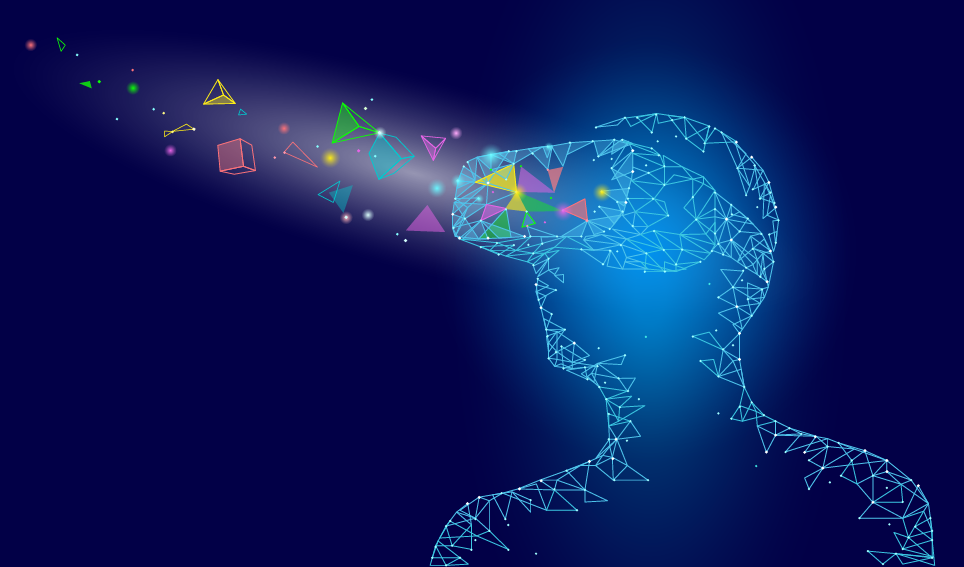
PATENT TRENDS: AUGMENTED REALITY WEARABLES
AR wearables are defined as any autonomous, noninvasive device that allows the user to interact with the real-world environment using computer-generated sensory input.
Who are the top industry players, and what are they patenting? According to IFI CLAIMS Patent Services:
- Top six U.S. patent assignees
- Samsung
- Sony Ericsson Mobile
- Santa Fe Science and Tech
- Percept Technology
- Zugara Inc.
- Most commonly patented device types
- Eyeglasses
- Head-mounted wear
- Devices that interact with the human body or body parts
NOTABLE WEARABLES PATENTS FROM 2018
In line with the trends identified above, here are a few wearables patents from 2018 that give a sampling of where wearables patent activity is heading. (Note that we didn’t evaluate these patents for validity, and we’re including them only for educational purposes.)
- Wearable device and translation system
- U.S. Patent 10,152,476 (Ishikawa)
- Assignee: Panasonic
- The invention is a “hearable” that automatically translates conversations between people speaking different languages in real time. MIT Technology Review named Babelfish earbuds as one of top ten breakthrough technologies of 2018; it’s unsurprising that competition in this field is starting to heat up.
- Systems and methods for utilizing identification devices in a wearable medical therapy device
- U.S. Patent 10,155,118 (Kaib, et al.)
- Assignee: Zoll Medical
- The invention is a portable, lightweight, and durable wearable defibrillator. It’s indicative of how wearables technology is poised to disrupt healthcare: by offering users time-sensitive interventions that could potentially spell the difference between life and death.
- Marking up scenes using a wearable augmented reality device
- U.S. Patent 10,134,194 (Kepner, et al.)
- Assignee: Evernote Corp.
- With investors in particular taking an outsized interested in AR wearables, businesses are searching for innovative ways to productively incorporate AR into daily life, beyond simply capturing real life scenes. This invention allows users to perform basic edits, annotations, and markups on captured scenes.
READY TO BEGIN PURSUING PATENT PROTECTION?
The wearables industry is certainly poised to grow exponentially over the next few years. So if you’ve got valuable wearables technology on your hands, you’ll want to pursue patent protection to exclude close competitors from exploiting your technology.
IS IT TIME TO START BUILDING YOUR PATENT PORTFOLIO? WE’LL HELP YOU FIND OUT!
When you’ve got game-changing technology on your hands, you can’t wait to share with the world — which also means protecting it from competitors.
But is now the right time to start moving forward with the patent process? Download our FREE checklist to find out. Learn the following:
- What does a patent really do?
- Does your invention have substance?
- Do you have all the necessary resources lined up?
- Is your business structure — and all the logistics — ironed out?
- How should you proceed if you’re not quite ready to begin the patent process?
Dive deep into the patent process and get all your IP readiness questions answered.
Fill out the short form on this page to download this checklist today!
GET THE FREE CHECKLIST

Michael K. Henry, Ph.D.
Michael K. Henry, Ph.D., is a principal and the firm’s founding member. He specializes in creating comprehensive, growth-oriented IP strategies for early-stage tech companies.

